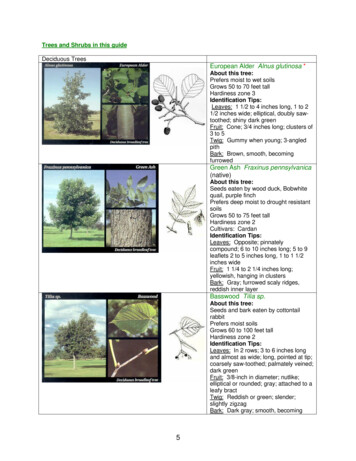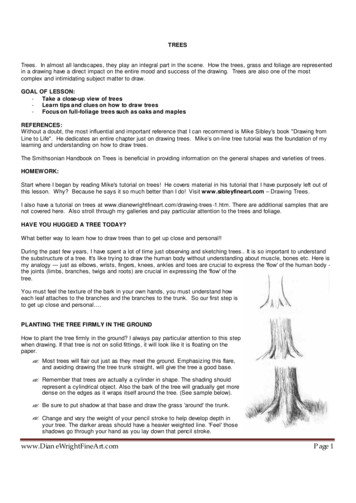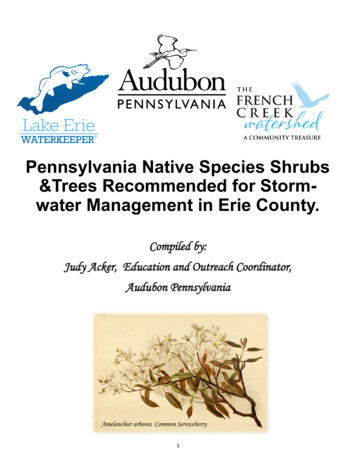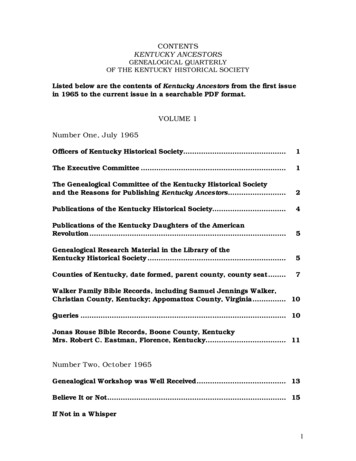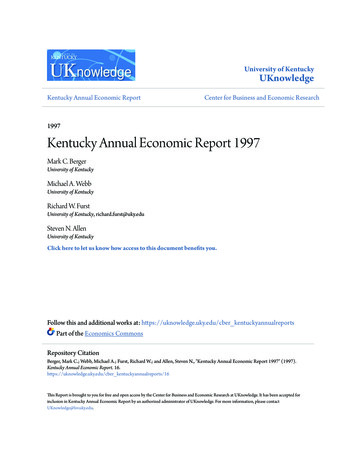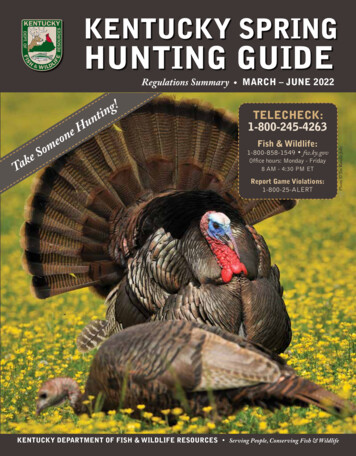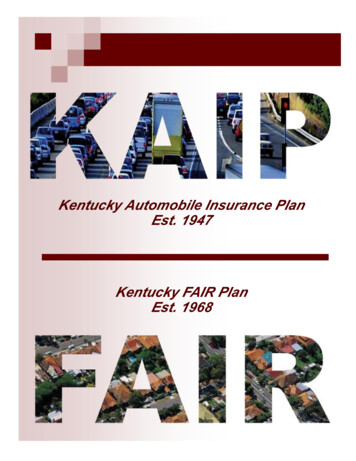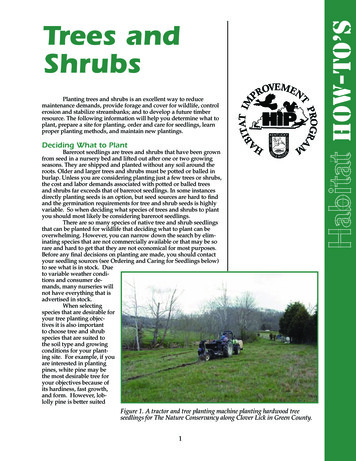
Transcription
Planting trees and shrubs is an excellent way to reducemaintenance demands, provide forage and cover for wildlife, controlerosion and stabilize streambanks; and to develop a future timberresource. The following information will help you determine what toplant, prepare a site for planting, order and care for seedlings, learnproper planting methods, and maintain new plantings.Deciding What to PlantBareroot seedlings are trees and shrubs that have been grownfrom seed in a nursery bed and lifted out after one or two growingseasons. They are shipped and planted without any soil around theroots. Older and larger trees and shrubs must be potted or balled inburlap. Unless you are considering planting just a few trees or shrubs,the cost and labor demands associated with potted or balled treesand shrubs far exceeds that of bareroot seedlings. In some instancesdirectly planting seeds is an option, but seed sources are hard to findand the germination requirements for tree and shrub seeds is highlyvariable. So when deciding what species of trees and shrubs to plantyou should most likely be considering bareroot seedlings.There are so many species of native tree and shrub seedlingsthat can be planted for wildlife that deciding what to plant can beoverwhelming. However, you can narrow down the search by eliminating species that are not commercially available or that may be sorare and hard to get that they are not economical for most purposes.Before any final decisions on planting are made, you should contactyour seedling sources (see Ordering and Caring for Seedlings below)to see what is in stock. Dueto variable weather conditions and consumer demands, many nurseries willnot have everything that isadvertised in stock.When selectingspecies that are desirable foryour tree planting objectives it is also importantto choose tree and shrubspecies that are suited tothe soil type and growingconditions for your planting site. For example, if youare interested in plantingpines, white pine may bethe most desirable tree foryour objectives because ofits hardiness, fast growth,and form. However, loblolly pine is better suitedFigure 1. A tractor and tree planting machine planting hardwood treeseedlings for The Nature Conservancy along Clover Lick in Green County.1Habitat How-to’sTrees andShrubs
to poorly drained soils and Virginia pine is better suited toshallow and excessively dry soils. Table 1 provides someuseful information for selecting tree and shrub species basedon your planting objectives and soil characteristics. Keep inmind that topography will greatly influence local growingconditions, north and east facing slopes generally hold moremoisture and have deeper soils than south and west facingslopes which tend to be droughty and have shallower soils.Before making final species selections, you may also want toconsult with your local resource professionals.Preparing A Site For PlantingFigure 2. Tree shelters can be usedto enhance survival and growth oftree and shrub seedlings.The tulip poplar, alsoknown as yellowpoplar or tuliptree,is Kentucky’s statetree and the tallestgrowing tree in theEastern UnitedStates.Site preparation is an important factor to consider intree planting and should be planned well before you intendto plant your tree or shrub seedlings. Controlling the existing vegetation on your planting site will generally improve seedlingestablishment and vigor, and in some situations may be necessaryfor survival. Generally, on good growing sites such as rich bottomlands or gently sloping upland sites with deep, well drained, siltyloam soils, site preparation is a necessity. The lush weedy growth ordense sod on these sites will choke out all but the hardiest seedlings.On poorer growing sites, particularly if pine is planted, plant competition is usually not as severe, and the faster growing pines can oftenovercome it with little or no help. As a rule of thumb, hardwoods aregenerally more sensitive to plant competition than pines, so regardless of site conditions some type of site preparation should be considered when planting hardwoods.Preparing a site for tree and shrub planting can be accomplished in a variety of ways. The two primary methods are conventional tillage and the use of herbicides. A herbicide treatmentor spraying is suitable for any area, but strongly recommended onany slopes with high erosion potential. The advantages of sprayinginclude less time from the landowner and minimal problems with soilerosion. You can also contract with a local farm store or a local farmerto have spraying done. On areas where topography is mild and thethreat of soil erosion is not a concern, conventional tillage can be aneffective means of site preparation. This involves either fall or springplowing and disking*, or rototilling, to prepare the site. For a detaileddescription of site preparation using herbicides and conventional tillage please see the Habitat How-To titled “Fescue Eradication”*.Ordering and Caring for SeedlingsTree and shrub seedlings can be ordered from a number ofstate run and private nurseries. The Kentucky Division of Forestryoperates two nurseries where a variety of low-cost seedlings aregrown for tree and shrub planting projects in the state. Order blanksmay be obtained from district offices, County Extension offices, andCounty Farm Service Agency offices. Listed on page 4 is contact information on some reputable nurseries that sell bareroot tree and shrubseedlings.The lack of proper care given to planting stock is a majorcause of seedling mortality. You should inspect your seedlings whenthey arrive. Check to see if your order was correct and examine theroots to see if they are moist. If the roots are dry to the touch andpowdery you should contact the nursery you purchased them fromand inquire about replacements. If only moderate drying has occurred and you intend to store your seedlings for several days, adding a little water to the package is recommended. Seedlings shouldbe stored at a temperature of about 40-45 degrees prior to planting.Temperatures above about 60 degrees can affect survival and growth.However, do not leave the seedlings where freezing is likely.If you need to store seedling for more than 10-14 days, eitherplace them in a cooler or refrigerator at 40-45 degrees or “heel” them2
(Not a complete list, butthese are commerciallyavailable.)TREESBaldcypressWhite PineLoblolly PineScotch PineShortleaf PineVirginia PineRed MapleSugar MapleBlack OakWhite OakNorthern Red OakSouthern Red OakBur OakPin OakCherrybark OakShumard OakWater OakWillow OakSwamp Chestnut OakSwamp White OakOvercup OakBlack WalnutPecanBlack LocustYellow PoplarWhite AshGreen AshSycamorePersimmonSweetgumWild Black CherryHackberrySHRUBSChinese ChestnutServiceberryFlowering DogwoodSilky DogwoodWild PlumAmerican HazelnutAmerican CranberryViburnumArrowwood ViburnumWhite MulberryRed MulberryRedbudBicolor LespedezaCrabappleWillowsSpecies of Treesand XXDesirableNuts XXXXXXNeeds DeepWell DrainedSoilsWill ToleratePoorlyDrainedSoilsDesirableFruits &BerriesSoil & RiparianBuffersEvergreenCover, WindBreaks &PrivacyHardwoodCover Thickets,Fence Rows, &Travel CorridorsTypes of ObjectivesXXXXXXXWill GrowOn ShallowExcessivelyDry SoilsTable 1. Trees and shrubs to plant based on objectives and soil characteristics.
Table 2. Tree and Shrub VendorsKentucky Division of Forestry627 Comanche TrailFrankfort, KY 40601502-654-4496 or1-800-866-0555Ripley County FarmsP.O. Box 614Doniphan, MO 63935573-996-3449rcf@semo.netCarino NurseriesP.O. Box 538Indiana, PA 157011-800-223-7075www.carinonurseries.comPine Grove NurseryR.D #3, Box 146Clearfield, PA 168301-800-647-1727Frank Clark and Associates, Inc.420 Lagoon Dr.McMinnville, TN 37110931-473-6449Nolin River Nut Tree Nursery797 Port Wooden Rd.Upton, KY, 42784270-369-8551Triangle Nursery, Inc.8526 Beersheba Hwy.McMinnville, TN 37110931-668-8022Hills Creek Nursery826 Hills Creek Rd.McMinnville, TN 37110931-668-8071Forrest Keeling Nursery, Inc.P.O. Box 135, Keeling LaneElsberry, MO 633431-800-356-2401www.fknursery.comHeeling In1. Dig V-shaped trench inmost shady place.2. Break bundles andspread out evenly.3. Fill in loose soil andwater well.4. Complete filling in soiland firm with feet.Figure 3. Storing trees and shrubs by“heeling in.”Correct and Incorrect DepthsIncorrectToo deep androots bent.Figure 4. Proper planting.Musser Forests, Inc.P.O. Box 340, Dept. 34Indiana, PA 15701724-465-5684Westvaco NurseryP.O. Box 1950Summerhill, SC 29484843-556-7584Melot’s Inc.8900 W. Memorial Rd.Oklahoma City, OK 73142405-721-4394CorrectAt same depth or1/2" deeper thanseedling grew innursery.National Wild Turkey FederationP.O. Box 530Edgefield, SC 298241-800-THE-NWTFIncorrectToo shallowand rootsexposed.Tennessee Div. of Forestry NurseryP.O. Box 59Delano, TN 37325423-263-1625Delta View NurseryRt. 1 Box 28Old Highway 61 SouthLeland, MS 387561-800-748-9018hardwoods@techinfo.comin the ground (Figure 3). To heel in seedlings, dig atrench deep enough for the roots to fit without bending. Gently separate the bundles, place the seedlingsin the trench, cover with soil to just slightly abovethe depth they were planted in the nursery, and firmup the loose soil with your feet. If watered regularly,seedlings can be kept in this manner for up to a year.However, be careful about waiting until seedlings leafout to plant them. Seedlings should be planted whilethey are still dormant. Do not keep the seedlings ina bucket of water. This will wash off valuable particles of soil attached to root hairs and may eventually“drown” the seedlings and kill your planting stock.Planting DatesTrees and shrubs should be planted duringthe dormant season, which occurs after hardwoodshave lost their leaves in the fall and before they beginto grow in the spring. The dormant planting seasonwill vary from year to year depending on weatherconditions. Spring planting is generally the recommended time to plant tree and shrub seedlings. Fallplanting is acceptable, but there are some disadvantages. Freezing during the winter months may causea winter kill on some seedlings and frost-heaving(freezing and thawing of the soil that can work seedlings loose) can be a serious problem for seedlingsplanted on bare ground or fine-textured soils.4
SpacingNo spacing recommendation can be considered optimum forall species in every situation. However, there are some generalizationsthat can be made. Table 3 gives the number of trees per acre for varietyof common spacings.There are several factors that can influence your decision onspacing. Do not plant on a spacing that is too narrow for your equipment. Shrub rows and cover thickets* are generally planted on a muchcloser spacing than whole field plantings. Most shrub and cover thicket plantings should be less than 6 feet apart. Whole field plantings ofpines or hardwood trees are generally not planted closer than 9 feetapart. Three hundred to 500 trees per acre in a reforestation project isusually considered adequate.Figure 5. Plantingspade or dibble bar.Planting MethodsTable 3. Trees per acre by spacing.Bareroot tree and shrub seedlings can be planted byhand or with a planting machine. In either case it is extremelySpacing (feet)Trees (number)important to make sure that 1) seedlings are planted at the same2x210,890depth they were planted in the nursery; 2) the soil is firmly4x44,840packed around the seedlings and there are no air pockets; and5x51,7423) seedling roots are pointed straight down, not bent or doubledup (J-rooted). Careless planting methods can result in significant6x61,210seedling mortality (Figure 4).7x7889Hand plantings are recommended for small projects7 x 10622(less than 1,000 seedlings), planting on sites too rough for7 x 12519planting machines, and planting seedlings with roots too large8x8681for planting machines. Seedlings can be hand planted using a8 x 10544planting bar (also called dibble bar or planting spade), mattock,8x12454shovel, or post-hole digger. When using a mattock, shovel, or9x9538post-hole digger a simple hole is dug, deeper than the seedling9 x 10484roots, and the seedling is held upright while refilling the hole9 x 12403and packing the loose dirt firmly around the seedling. Plant10 x 10436ing bars provide a more streamlined planting approach and areoften the preferred tool for hand planting seedlings (Figure 5).10 x 12363Using a planting bar (Figure 6), a slit is made in the ground, theseedling’s roots are place in the slit, and the plantingbar is used again to push the opening closed. PlantingDibble Plantingbars are available on a loan basis from the KentuckyDivision of Forestry and the Kentucky Department ofFish and Wildlife Resources.Dibble or Planting BarTree planting machines offer a fast, effective,and economical method for planting seedlings onlarge projects (more than 1,000 seedlings) where thesoils and topography are suitable. Most planting machines consist of a rolling coulter that cuts the ground3. Insert dibble2. Remove dibble1. Insert dibble atsurface, followed by a an adjustable trencher thatangle shown and2 inches towardand place seedlingpush forward toplanter fromat correct depth.creates a slit for inserting seedlings, which is followedupright position.seedling.by a set of packing wheels that firm up the soil aroundthe seedling. A 50 hp. or larger tractor is needed topull a planting machine, although slightly smallertractors may work in some situations depending onthe size of the planting machine. A 3 to 4 man crew is4. Pull handle5. Push handle of6. Insert dibble 2of dibble towarddibble forward frominches from lastgenerally needed to man the tractor and planting maplanter firming soilplanter firming soil athole.chine and have someone walk behind the planter toat bottom of roots.top of roots.make sure seedlings are being planted properly. Treeplanting machines are available on a loan basis fromthe Kentucky Division of Forestry.MaintenanceEven the best initial site preparation maygive way to aggressive, competitive vegetation thatcan stunt seedling growth or completely smothernew seedlings. Efforts should be made to control this57. Push forwardthen pull backwardfilling hole.8. Fill in last hole bystamping with heel.9. Firm soilaround seedlingwith feet.Figure 6. Planting by hand.
SUMMARYOF OPTIONS:Species SelectionSpacingOrdering SeedlingsSite PreparationStorage and Care of SeedlingsHand or Machine PlantingMaintenanceFigure 7. A mixed evergreen and hardwood tree plantingalong a field border.*Related Habitat How-Toreferences:Cover ThicketsFescue EradicationStreamside ManagementShallow-water WetlandsWildlife CorridorsStrip DiskingFencingcompetition for the first few growing seasons to ensure your tree andshrub planting efforts will be successful. After the second or thirdgrowing season the seedlings usually outgrow the surrounding vegetation, and weed control is no longer necessary. Most tree and shrubplantings are maintained by periodic mowing to keep surroundingvegetation lower than newly planted seedlings. There are effectiveherbicides that can be used to maintain new plantings. If you are interested in using herbicides to maintain your tree and shrub planting,you should consult with your local forester or biologist for up to datemaintenance information. Also, keep in mind that for some wildlifeplantings, such as shrub rows or cover thickets where the spacingis too close for mowing, unmanaged native plant growth may be adesirable component of your project.Fencing and Tree SheltersYour planting project should be fenced to protect seedlings fromgrazing damage if livestock are present. Rabbits, small rodents, anddeer may browse or girdle seedlings in some situations. Some wildlifedamage problems can be solved using tree shelters or wildlife deterrents. If you notice seedling mortality you should consult with your forester or wildlife biologist to determine the cause and potential remedies.Planning for My PropertyThe Kentucky Department of Fish andWildlife Resources does not discriminate onthe basis of race, color, national origin, sex,religion, age or disability in employment orthe provision of services and provides, uponrequest, reasonable accommodation including auxiliary aids and services necessary toafford individuals with disabilities an equalopportunity to participate in all programs andactivities.If you feel you have been discriminatedagainst by this department, contact theKentucky Department of Fish and WildlifeResources Commissioner’s Office, #1 GameFarm Road, Frankfort, KY 40601.A portion of this publication was underwritten by the Forest Stewardship Program incooperation with the Kentucky Division ofForestry.6
e conditions, north and east facing slopes generally hold mor e and have deeper soils than south and west facing moistur oughty and have shallower soils. slopes which tend to be dr e making final species selections, you may also want to Befor ofessionals. ce pr esour
